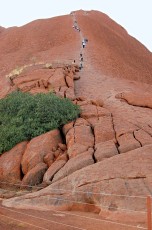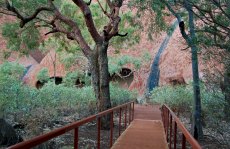| The most intriguing experience is sunrise
or sunset at the
Uluru. Depending on weather conditions and incident of light
the huge rock can change its colour from a pale grey-red into a
glowing orange or even fiery red and after that fades again. We
experienced both, sunrise in a clear sky and sunset, when the sky
was heavy with storm clouds. It is really lucky to experience this
as, when the sun brakes through the dark clouds, the most contrasting
colours appear. A spectacle beyond comparison!
Spiritual heart of Australia
Many oddly shaped rock formations, caves, springs and water holes
and, above all, the way the rock magically changes colour at sunrise
and sunset, gave rise to numerous legends. No wonder, that the Uluru
became a sacred site to the Anangu Aboriginal
people and with it the Red Centre
the spiritual heart of Australia. On rock caves and shelters still
today well preserved ancient paintings can be found and bear witness
to Aboriginal art and culture. The Uluru is listed as a World Heritage
Site for its exceptional natural and man-made attributes.
 There are many
guidedexcursions including the tough 1.6 km ascent to the top of
the Uluru, but you can easily explore this mysterious place on your
own account, supported by brochures, or just following the marked
paths, which guide you to the most interesting and sacred sites.
The major walk leads around the base of the Uluru, but there
are also shorter walks. They all reflect in their own special way
the mystery of dreamtime and give an inside into ancient Aboriginal
culture. We decided on the two km long
Mala walk, which tells of the arrival of the Mala people
at the Uluru and the only 0,5 km long walk to Mutitjulu,
a reliable water
hole, which is an extremely important cultural site. The Mala
Walk is also the starting point for
Uluru climbing,
but it is requested, that you respect the feelings of Anangu by
not climbing the Uluru. There are many
guidedexcursions including the tough 1.6 km ascent to the top of
the Uluru, but you can easily explore this mysterious place on your
own account, supported by brochures, or just following the marked
paths, which guide you to the most interesting and sacred sites.
The major walk leads around the base of the Uluru, but there
are also shorter walks. They all reflect in their own special way
the mystery of dreamtime and give an inside into ancient Aboriginal
culture. We decided on the two km long
Mala walk, which tells of the arrival of the Mala people
at the Uluru and the only 0,5 km long walk to Mutitjulu,
a reliable water
hole, which is an extremely important cultural site. The Mala
Walk is also the starting point for
Uluru climbing,
but it is requested, that you respect the feelings of Anangu by
not climbing the Uluru.
|